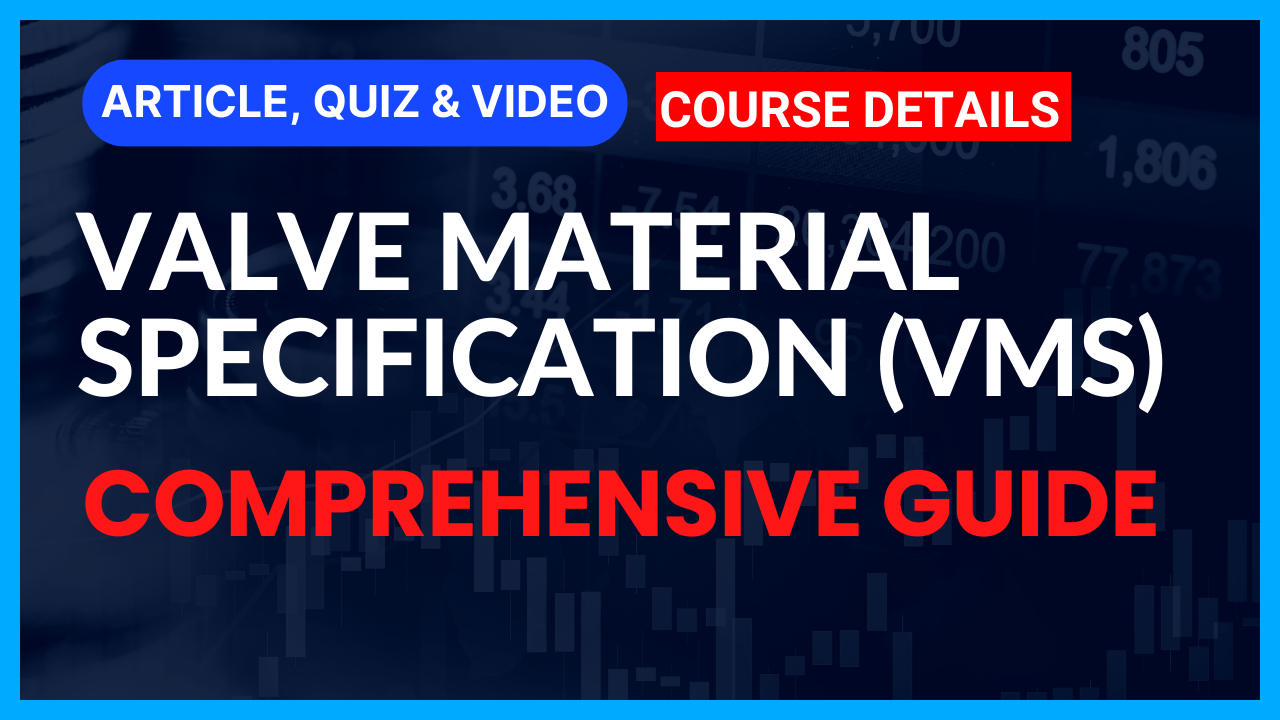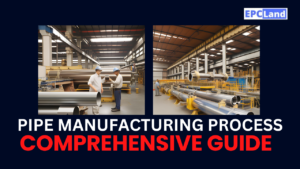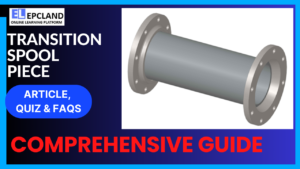Introduction
In the realm of valve manufacturing and usage, Valve Material Specifications (VMS) play a pivotal role in ensuring the reliability, safety, and performance of valves across various industries. This comprehensive course delves into the intricate details of VMS, providing valuable insights into the materials, standards, and components that constitute the foundation of well-designed and functional valves.
Check out the Course on Valve Material Specification
Enrollment Link
Table of Contents
Section 1: Introduction to Valve Material Specification
1.1 Scope
At the heart of this course lies a comprehensive exploration of Valve Material Specifications (VMS) and the critical factors they encompass. The scope of the course encompasses a wide range of topics, delving into valve materials, standards, construction, and selection criteria. By delving into the essential components of VMS, this course equips participants with the knowledge necessary to understand, interpret, and implement these specifications effectively.
1.2 Abbreviation
Navigating the landscape of valve materials and specifications often involves deciphering numerous abbreviations that are fundamental to the field. In this section, participants will become well-versed in the shorthand used to denote various valve materials, components, and standards. A clear understanding of these abbreviations is essential for effective communication and interpretation within the industry.
1.3 Reference Documents
In the world of valve material specifications, accuracy and consistency are paramount. This segment of the course sheds light on the reference documents that serve as the backbone of VMS. Participants will gain insight into the authoritative sources that guide the creation, interpretation, and implementation of valve material specifications, ensuring that the valves produced adhere to industry standards and best practices.
1.4 Valve Numbering System
Efficient cataloging and identification of different types of valves are crucial for streamlined communication and operations. This section introduces participants to the Valve Numbering System, a structured approach to categorizing and distinguishing between various valve types. By understanding this system, participants will be better equipped to navigate the world of valves and their specifications.
1.5 General Notes
General notes within valve material specifications provide context and additional instructions that guide the manufacturing and application of valves. In this part of the course, participants will gain an understanding of the significance of general notes, ensuring that they can accurately interpret and adhere to these essential guidelines.
1.6 Attachments
Supplementary materials, or attachments, often accompany valve material specifications to provide further clarification and details. This section of the course delves into the types of attachments that may be encountered and explains how to effectively utilize these materials to enhance comprehension and implementation of valve specifications.
The introductory section of the course sets the stage for a comprehensive exploration of Valve Material Specifications (VMS). Participants are equipped with an understanding of the course’s scope, the importance of abbreviations, the role of reference documents, the significance of the Valve Numbering System, the relevance of general notes, and the utilization of attachments. Armed with this foundational knowledge, participants are prepared to delve deeper into the intricate world of valve materials, standards, and construction as the course progresses.
Enrollment Link

Fundamental Concepts
Section 2: Fundamental Concepts on Valve Material Specification
In the ever-evolving landscape of valve manufacturing and utilization, understanding fundamental concepts is the cornerstone of ensuring precision, safety, and quality. This section of the course delves deep into the core principles that underpin Valve Material Specifications (VMS), equipping participants with the essential knowledge to navigate the intricate world of valve materials and specifications effectively.
2.1 Scope
Explanation of the Scope
At the heart of this section lies a comprehensive elucidation of the scope of the course. Participants will gain a clear understanding of the breadth and depth of topics covered within Valve Material Specifications (VMS). This includes an exploration of valve materials, standards, construction, and selection criteria. By delving into the scope of the course, participants will be well-prepared to navigate the subsequent sections with insight and purpose.
2.2 Abbreviation
Deciphering Common Abbreviations
In the realm of valve materials and specifications, the usage of abbreviations is ubiquitous. This subsection engages participants in an in-depth discussion of the most frequently used abbreviations in the field. By decoding these abbreviations, participants will enhance their ability to communicate, interpret, and implement valve material specifications accurately. A clear grasp of these shorthand notations is vital for effective collaboration and compliance within the industry.
2.3 Reference Documents
Unlocking Essential Reference Documents
The accuracy and consistency of Valve Material Specifications (VMS) hinge on the guidance provided by reference documents. This portion of the course unveils the critical role of these documents in the creation and interpretation of valve material specifications. Participants will gain insight into key industry standards and authoritative sources that guide the manufacturing process. By mastering the art of navigating reference documents, participants will ensure that their valve specifications align with industry best practices and standards.
2.4 Valve Numbering System
Navigating the Valve Numbering System
The Valve Numbering System is a cornerstone of organized valve cataloging and identification. This segment provides participants with an overarching view of how this system functions. By delving into the Valve Numbering System, participants will grasp the methodology behind categorizing and differentiating between various valve types. This knowledge is instrumental in streamlining communication, procurement, and operational efficiency within the industry.
2.5 General Notes
Significance of General Notes
Within Valve Material Specifications (VMS), general notes offer supplementary instructions and contextual information. This part of the course engages participants in a thoughtful exploration of the importance of these notes. By comprehending the significance of general notes, participants can effectively interpret and implement these additional guidelines, contributing to the precision and quality of valve manufacturing processes.
2.6 Attachments
Unveiling Supplementary Materials
Attachments, as accompanying materials in valve material specifications, provide a deeper layer of understanding. This segment sheds light on the nature and role of attachments in enhancing comprehension and implementation. Participants will gain insight into how to utilize these supplementary materials to glean additional insights and nuances from valve material specifications.
The Fundamental Concepts section of the course serves as a gateway to a comprehensive understanding of Valve Material Specifications (VMS). By exploring the scope, decoding abbreviations, understanding reference documents, grasping the Valve Numbering System, appreciating the significance of general notes, and leveraging attachments, participants establish a strong foundation. This foundation will enable them to navigate the intricate world of valve materials and specifications with confidence and expertise as they progress through the subsequent sections of the course.
Enrollment Link
Valve Index and Datasheets
Section 3: Valve Index and Datasheets: Valve Material Specification
In the intricate world of Valve Material Specifications (VMS), precise documentation and information dissemination are vital for seamless communication, manufacturing, and implementation. This section of the course delves into two crucial components – the Valve Index and Valve Datasheets. Additionally, it sheds light on the essential aspect of Inspection Requirements, ensuring that participants are well-equipped to navigate the complexities of valve material specifications effectively.
Valve Index
Unveiling the Purpose and Content of a Valve Index
Central to the organization and accessibility of valve material specifications is the Valve Index. This subsection unveils the importance of a Valve Index in providing a comprehensive list of various valve types encompassed by the material specifications. Participants will gain a clear understanding of how the Valve Index aids in streamlining communication, cataloging, and referencing different types of valves, enabling efficient access to pertinent information.
Valve Datasheets
The Role of Valve Datasheets in Specifying Requirements
Valve Datasheets serve as a crucial bridge between theory and practice within the realm of valve material specifications. This part of the course delves into the purpose and significance of Valve Datasheets. Participants will engage in a comprehensive discussion on the information encapsulated within these datasheets, including details about valve components, materials, dimensions, and operational parameters. By exploring the role of Valve Datasheets, participants will grasp their pivotal role in facilitating informed decision-making during valve manufacturing, selection, and application processes.
Inspection Requirements
Overview of Adhering to Inspection Requirements
The quality and reliability of valves hinge on adherence to meticulous inspection processes. This subsection provides participants with a comprehensive overview of Inspection Requirements within valve material specifications. Participants will understand the importance of stringent inspections, from raw materials to the final product, to ensure compliance with industry standards and regulatory guidelines. By mastering the nuances of Inspection Requirements, participants contribute to the safety and performance of valves across various industries.
The Valve Index and Datasheets section of the course serves as a gateway to understanding the practical aspects of Valve Material Specifications (VMS). By uncovering the significance of the Valve Index and comprehending the role of Valve Datasheets, participants are equipped to navigate the complexities of valve types, specifications, and requirements. Additionally, by delving into Inspection Requirements, participants underscore the importance of quality assurance and regulatory compliance. Armed with this knowledge, participants are primed to proceed with confidence into the subsequent sections of the course, where they will explore the materials, construction, and standards associated with valves in greater depth.
Enrollment Link
Material Section of Valves in Valve Material Specification
Section 4: Material Section of Valves
In the domain of valve manufacturing, understanding the intricate details of materials is paramount. This section of the course delves into the Material Section of Valves, a cornerstone of Valve Material Specifications (VMS). By exploring the chemical and mechanical properties of different materials, participants will gain the knowledge needed to make informed decisions about valve construction, ensuring safety, reliability, and optimal performance across various applications.
Material Section of Valves
Exploring the Composition and Properties of Valve Materials
At the core of this section lies an in-depth exploration of the Material Section of Valves, where participants will uncover the chemical and mechanical properties of various materials used in valve construction. This exploration encompasses a range of materials, including:
- Carbon Steel Valves (ASTM Standards): Participants will dive into the specifications for carbon steel valves, understanding how these materials respond to different environments and operational conditions.
- Low-Temperature Carbon Steel (ASTM Standards): This subsection delves into the properties and suitability of low-temperature carbon steel for applications in extreme cold environments.
- Stainless Steel (ASTM Standards): Participants will explore the unique attributes of stainless steel, including its corrosion resistance and durability, as outlined in ASTM Standards.
- High-Temperature Carbon Steel (ASTM Standards): This part of the course discusses the properties of high-temperature carbon steel, vital for applications that involve elevated temperatures and pressures.
By comprehending the chemical makeup, mechanical attributes, and inherent strengths of these materials, participants will be empowered to select the most appropriate materials for specific valve applications.
The Material Section of Valves is a pivotal aspect of Valve Material Specifications (VMS) that influences the performance and reliability of valves across industries. By delving into the chemical and mechanical properties of carbon steel, low-temperature carbon steel, stainless steel, and high-temperature carbon steel, participants are equipped with the knowledge to make well-informed decisions about valve materials. As participants progress through the subsequent sections of the course, they will build upon this foundation, gaining deeper insights into valve construction, industry standards, and the anatomy of valves.
Enrollment Link
Anatomy of Gate Valves as per API Standards
Section 5: Anatomy of Gate Valves as per API Standards
Within the world of valve engineering, comprehending the intricacies of valve components is essential for designing, manufacturing, and using valves effectively. This section of the course delves into the Anatomy of Gate Valves as defined by the American Petroleum Institute (API) Standards. By understanding the components and structures outlined in these standards, participants will gain valuable insights into the construction, operation, and maintenance of gate valves.
Anatomy of Gate Valves as per API Standards
Deconstructing Gate Valve Components
At the core of this section is an exploration of the Anatomy of Gate Valves as defined by API Standards. Participants will delve into the intricate details of these valves, understanding the components that make up their structure, functionality, and operational characteristics. This exploration covers gate valves based on various API Standards:
- Components of API 600: Participants will gain insight into the components specified in API 600, focusing on their roles and interactions within the valve assembly.
- Components of API 602: This subsection explores the components outlined in API 602, providing participants with a comprehensive view of the compact forged steel valves used in various applications.
- Components of API 6D: Delving into API 6D, participants will understand the components involved in pipeline and piping valves, contributing to safe and efficient fluid transport.
- Components of API 6A: The components defined in API 6A for wellhead and Christmas tree equipment are explored, offering insights into critical components used in the oil and gas industry.
By grasping the intricate relationships between different valve components, participants will enhance their ability to design, select, and maintain gate valves in line with API Standards.
The Anatomy of Gate Valves as per API Standards is a crucial aspect of valve engineering that underscores the importance of component understanding. By dissecting the components outlined in API 600, API 602, API 6D, and API 6A, participants gain a deeper insight into the inner workings of these valves. Armed with this knowledge, participants are poised to delve further into the world of API Standards, materials, and operational considerations as they progress through the subsequent sections of the course.
Enrollment Link
Material Selection Criteria
Section 6: Material Selection Criteria
The selection of materials for valve trims and non-trims is a critical decision in valve engineering, directly influencing the performance and longevity of valves. This section of the course delves into the intricate process of material selection, providing participants with the tools to make informed decisions based on industry standards and practical considerations.
Material Selection Criteria of Valve Trims & Non-Trims
Choosing the Right Materials for Optimal Performance
At the heart of this section lies an exploration of the material selection criteria for valve trims and non-trims. Participants will delve into the following key aspects:
- Trims & Non-trims Identifications: Understanding the components that constitute valve trims and non-trims and how their materials impact valve performance.
- Understanding the Information Sources & Sequences: Navigating the wealth of information from API Standards and other reference documents to make informed material selections.
- Extracting the Clauses & Tables from API Standards: Learning how to extract and interpret the relevant clauses and tables from API Standards to guide material selection decisions.
By understanding the factors that influence material selection, participants will be equipped to choose materials that align with operational requirements, durability expectations, and industry best practices.
The Material Selection Criteria section equips participants with a comprehensive understanding of the intricate process of selecting materials for valve trims and non-trims. By exploring trims and non-trims identification, understanding information sources, and effectively extracting information from API Standards, participants are prepared to make well-informed decisions that directly impact valve performance, reliability, and safety. As participants continue through the subsequent sections, their mastery of material selection criteria will serve as a valuable foundation for exploring valve construction, standards, and practical applications.
Enrollment Link
Conclusion
The concluding section of this comprehensive course marks a significant milestone in the journey of understanding Valve Material Specifications (VMS) and the intricate world of valve engineering. This section serves as a recapitulation and reflection on the key takeaways, insights, and skills gained throughout the course.
Recapitulating the Learning Journey
The Conclusion section provides a concise recap of the fundamental concepts explored in the course. Participants are reminded of the scope of the course, the significance of understanding abbreviations, the importance of reference documents, the utility of the Valve Numbering System, the relevance of general notes, and the role of attachments. This recap sets the stage for participants to appreciate the depth of knowledge acquired in navigating the nuances of valve materials and specifications.
Reflecting on Practical Applications
Participants are encouraged to reflect on how the knowledge gained in this course can be applied to real-world scenarios. The Anatomy of Gate Valves as per API Standards has equipped participants with a profound understanding of valve components and their roles. This understanding, coupled with insights into valve index, datasheets, and inspection requirements, empowers participants to make informed decisions at every stage of valve design, manufacturing, and utilization.
Embracing a Strong Foundation
The Conclusion section emphasizes that the knowledge acquired in this course forms a robust foundation for further exploration in the field of valve engineering. Understanding Valve Material Specifications (VMS) is not merely an academic pursuit; it is a practical skill that contributes to the safe, efficient, and reliable operation of industrial systems.
Continuing the Learning Journey
As the course concludes, participants are encouraged to continue their learning journey by exploring advanced topics related to valve engineering, materials science, and industry standards. The resources, insights, and skills gained from this course will serve as valuable tools as participants navigate the evolving landscape of valve technologies and applications.
Final Thoughts
The Conclusion section encapsulates the essence of the course by summarizing the core concepts, highlighting their practical applications, and emphasizing the value of the acquired knowledge. Armed with this knowledge, participants are poised to embark on a journey of continual learning and growth within the realm of valve engineering and materials specifications.
FAQs
Frequently asked questions (FAQs) that participants might have about the course on Valve Material Specifications (VMS):
- Why are Valve Material Specifications (VMS) important? Valve Material Specifications (VMS) are crucial because they ensure the reliability, safety, and performance of valves in various industries. These specifications define the materials, standards, and construction methods required to manufacture valves that can withstand specific operational conditions, fluids, and pressures.
- What is the role of API Standards in valve engineering? API (American Petroleum Institute) Standards provide comprehensive guidelines and industry best practices for various aspects of valve engineering, including design, materials, manufacturing, and testing. Adhering to API Standards ensures consistency, quality, and regulatory compliance in valve production.
- What is the significance of a Valve Index and Valve Datasheets? A Valve Index is a comprehensive list of various types of valves covered in material specifications. It aids in identifying and categorizing different valve types. Valve Datasheets, on the other hand, contain detailed information about valve components, materials, dimensions, and operational parameters. They play a crucial role in specifying valve requirements and facilitating informed decision-making.
- Why is understanding the Anatomy of Gate Valves important? Understanding the Anatomy of Gate Valves as per API Standards is essential for designing, selecting, and maintaining gate valves effectively. It helps participants grasp the individual components’ functions, interactions, and operational characteristics, ensuring that valves perform optimally in diverse applications.
- How can the knowledge gained from this course be applied in practice? The knowledge gained from this course can be applied in various practical scenarios. Participants can use their understanding of Valve Material Specifications to make informed decisions during valve design, material selection, manufacturing, and maintenance. They can also navigate reference documents, interpret general notes, and effectively utilize valve datasheets to ensure compliance with industry standards.
Recommended courses (Published on EPCLand)
- Basics of Piping Engineering
- Piping Layout Engineering
- Piping Material Engineering
- Piping Stress Analysis
- Complete Course on Piping Engineering
- Material Requisitions
- Piping Material Specifications
- Valve Material Specifications
Don’t miss the published articles on following:
Related Video
Attempt Quiz on VMS
Question 1:
What is the purpose of Valve Material Specifications (VMS)?
Explanation: Valve Material Specifications (VMS) are used to establish guidelines and standards for the selection of suitable materials for valve construction, ensuring compatibility with the intended application.
Question 2:
Which factors are typically considered when developing Valve Material Specifications?
Explanation: Valve Material Specifications take into consideration factors such as chemical compatibility, temperature, pressure, and service conditions to ensure that the selected material will perform well in the intended application.
Question 3:
Why is the selection of valve materials important?
Explanation: The selection of valve materials is crucial as it directly impacts the performance, durability, and reliability of the valve in the specific operating conditions it will be exposed to.
Question 4:
Which organization is known for developing industry standards for Valve Material Specifications?
Explanation: The American Society of Mechanical Engineers (ASME) is known for developing industry standards, including Valve Material Specifications, to ensure the quality and performance of valves.
Question 5:
What is the primary goal of Valve Material Specifications?
Explanation: The primary goal of Valve Material Specifications is to ensure that valves are constructed using materials that are well-suited for the specific conditions and applications they will be exposed to.



